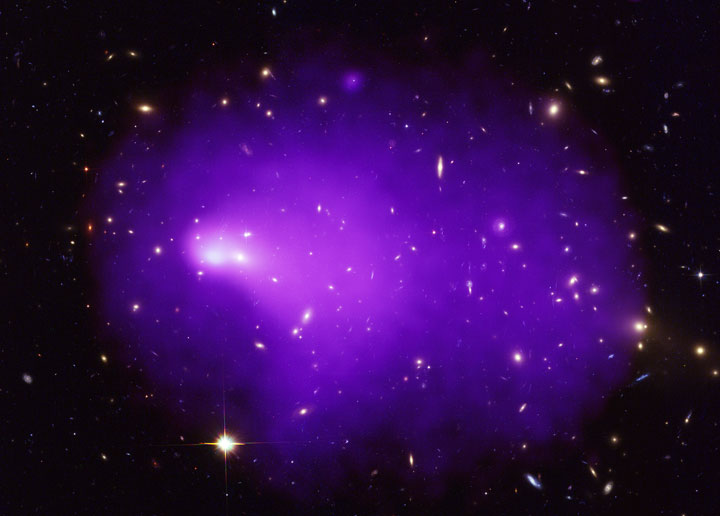
July 23, 2019, by Lindsay Brooke
Breath-taking image: Helen’s honour as NASA celebrates astronomy landmark
NASA is today celebrating the 20th anniversary of the Chandra X-ray Observatory. It also has special significance for University of Nottingham astronomer Dr Helen Russell – together with her collaborators, she captured this breath-taking image being shared around the world by NASA to illustrate a landmark in furthering our understanding of the cosmos.
Dr Russell, now an STFC Rutherford and Anne McLaren Research Fellow in the School of Physics and Astronomy, made the first Chandra image of this target as a PhD student as she embarked on a career as an observational astronomer studying the structure of galaxies.
She has since been awarded a legacy-class observing program of this target with Chandra. The images are produced using the telescope’s highly polished mirrors which focus X-ray light onto a Charge Coupled Device (CCD) detector – a much larger version of the device in your phone’s camera! CCD detects light and turns it into an electrical signal that’s read by the telescope’s computer.
What is Chandra?
On July 23, 1999, the Space Shuttle Columbia blasted off from the Kennedy Space Center carrying the Chandra X-ray Observatory. In the two decades that have passed, Chandra’s powerful and unique X-ray eyes have contributed to a revolution in our understanding of the cosmos.
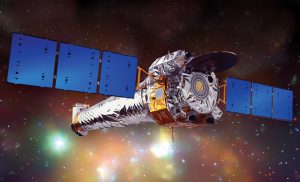 Chandra is one of NASA’s “Great Observatories” (along with the Hubble Space Telescope, Spitzer Space Telescope, and Compton Gamma Ray Observatory), and has the sharpest vision of any X-ray telescope ever built.
Chandra is one of NASA’s “Great Observatories” (along with the Hubble Space Telescope, Spitzer Space Telescope, and Compton Gamma Ray Observatory), and has the sharpest vision of any X-ray telescope ever built.
“Chandra remains peerless in its ability to find and study X-ray sources,” said Chandra X-ray Center Director Belinda Wilkes. “Since virtually every astronomical source emits X-rays, we need a telescope like Chandra to fully view and understand our Universe.”
Chandra detects X-ray light from very hot and energetic phenomena in the Universe, including gas spiralling into black holes and vast clusters of galaxies.
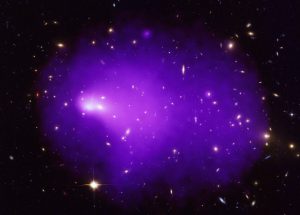 Dr Russell’s image is a Hubble/Chandra composite showing the merger of two clusters of galaxies – Abell 2146. She said: “Over the past two decades, Chandra has made numerous profound discoveries about the cosmos and I am honoured that my observations will help to celebrate its legacy.”
Dr Russell’s image is a Hubble/Chandra composite showing the merger of two clusters of galaxies – Abell 2146. She said: “Over the past two decades, Chandra has made numerous profound discoveries about the cosmos and I am honoured that my observations will help to celebrate its legacy.”
She added: “Modern astronomy seeks to understand how the galaxies seen in the local Universe, like our own Milky Way, formed over the last 13 billion years. My research explores the impact of the most energetic events in the lives of these galaxies – powerful jetted outbursts from their central supermassive black hole and massive collisions between huge clusters of galaxies.
“Major cluster mergers are the most energetic events in the Universe since the Big Bang. The energy generated by the collision is dissipated in shocks and turbulence, which heat up and disrupt the hot gas atmospheres surrounding the constituent galaxies. Abell 2146 is a major merger between two clusters and, most unusually, hosts two vast shock fronts, which I will study in detail with the new ultradeep Chandra observations.”
What is Abell 2146?
The colossal system Abell 2146 is the result of a collision and merger between two galaxy clusters. Astronomers think that galaxy clusters, the largest structures in the Universe held together by gravity, grow by colliding and merging with one another. Mergers of galaxy clusters are some of the most energetic events since the Big Bang. Chandra has observed many galaxy cluster mergers, giving scientists insight into how these mega-structures that dominate the Universe came to be.
In this image of Abell 2146, X-rays from Chandra (purple) show hot gas and optical data from the Hubble Space Telescope shows galaxies and stars. The bullet-shaped feature shows the hot gas from one cluster plowing through the hot gas in the other cluster.
A suite of anniversary images
This image is part of an assembly of new images released to commemorate the 20th anniversary of NASA’s Chandra X-ray Observatory. They represent the breadth of Chandra’s exploration, demonstrating the variety of objects it studies as well as how X-rays complement the data collected in other types of light. Some of these images contain Chandra data exclusively and the rest show how X-rays fit with the different types of light that other telescopes collect.
The 20th anniversary images are from left to right:
Top row:
Abell 2146 – Credit: X-ray: NASA/CXC/Univ. of Waterloo/H. Russell et al.; Optical: NASA/STScI; White et al
Sagittarius A* – Credit: X-Ray:NASA/CXC/UMass/D. Wang et al.; Radio:NRF/SARAO/MeerKAT
30 Doradus – Credit: NASA/CXC/Penn State Univ./L. Townsley et al.
Bottom row:
Cygnus OB2 – Credit: X-ray: NASA/CXC/SAO/J. Drake et al; H-alpha: Univ. of Hertfordshire/INT/IPHAS; Infrared: NASA/JPL-Caltech/Spitzer
NGC 604 – Credit: X-ray: NASA/CXC/CfA/R. Tuellmann et al.; Optical: NASA/AURA/STScI/J. Schmidt
G292.0+1.8 – Credit: NASA/CXC/SAO
There’s plenty more information on the Chandra website.
What else is in store?
Dr Russell is working on brand new Chandra observations of this cluster merger – a legacy-class dataset which is almost done. She also studies the impact of supermassive black holes on their host galaxies using both Chandra and ALMA observations. ALMA is the Atacama Large Millimeter Array. The brand new observations are almost done and NASA will be revealing more about this in the near future.
What it means to be an Anne McLaren Fellow at Nottingham
Dr Russell joined Nottingham from the University of Cambridge as an STFC Rutherford and Anne McLaren fellow. Anne McLaren fellowships are aimed at outstanding female scholars in science, technology, engineering and medicine, who are at the early stage of their academic careers and wish to establish a research career in the UK.
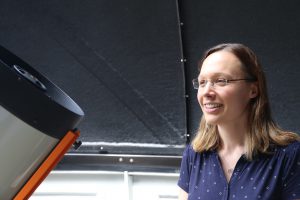 She said: “I now have the opportunity to lead my own projects, explore my own ideas and pursue funding to build my own research team. I am very proud and grateful to hold one of these prestigious fellowships that is making a real difference in retaining women in STEM fields.”
She said: “I now have the opportunity to lead my own projects, explore my own ideas and pursue funding to build my own research team. I am very proud and grateful to hold one of these prestigious fellowships that is making a real difference in retaining women in STEM fields.”
“Nottingham provides a very supportive environment for my research with a breadth of expertise in extragalactic astronomy and cosmology. I was a Nottingham Physics undergraduate student and inspired to pursue astronomy research by great mentors in the department, including Dr Meghan Gray, herself an Anne McLaren Fellow at the time.
“I started my fellowship only three weeks ago, on returning from maternity leave, and I have found the School of Physics & Astronomy to be very welcoming and supportive. A new job, new city and a new baby, all at the same time, has been a huge adjustment for me. Nottingham have been very understanding and flexible and helped to make this a very positive transition.”
No comments yet, fill out a comment to be the first

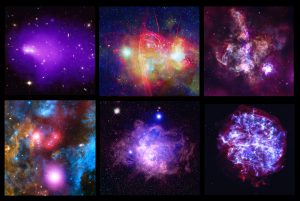
Leave a Reply